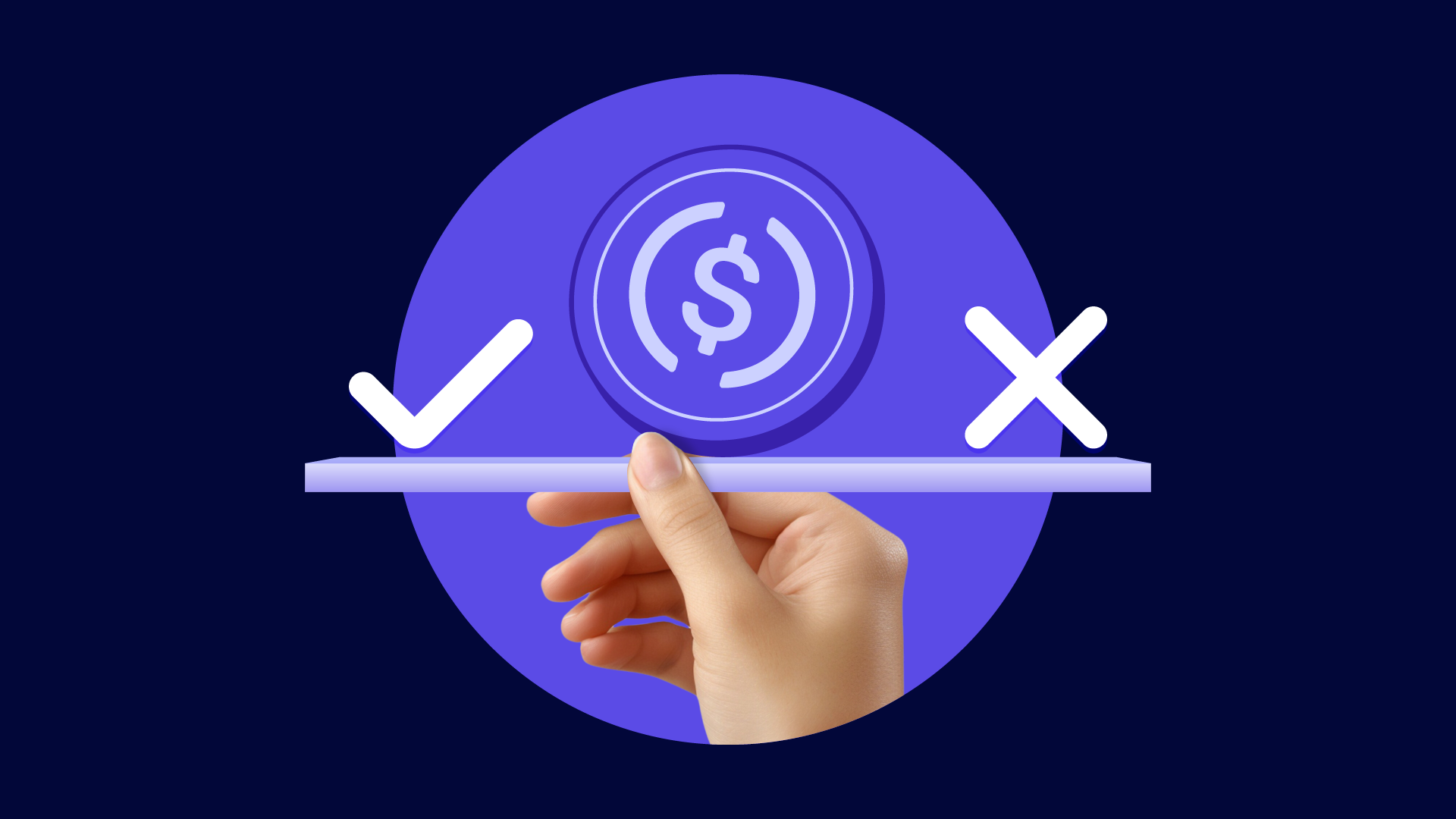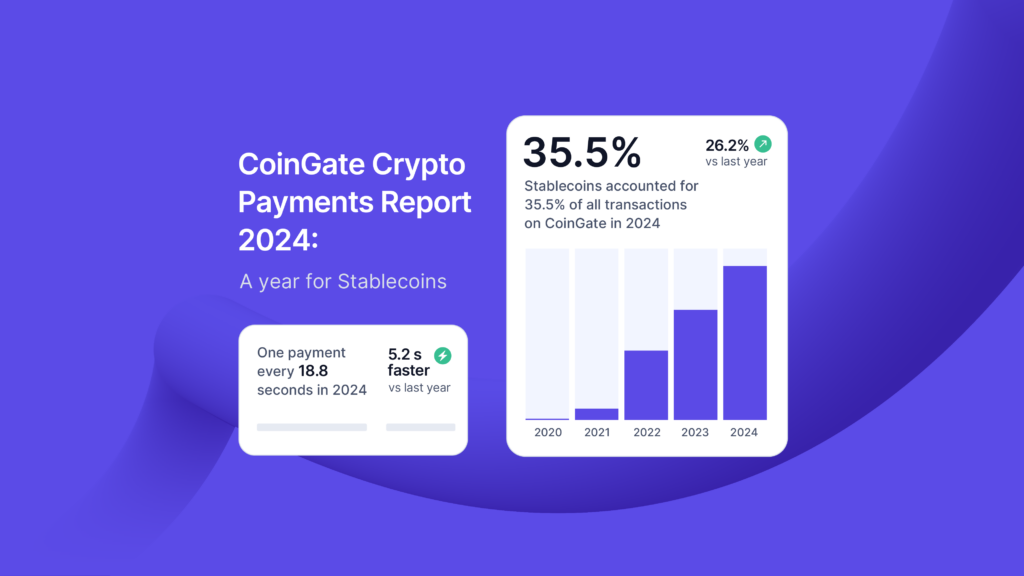
How Do Stablecoins Work? A Simple Guide

Stablecoins are a special type of cryptocurrency designed to hold a steady value, usually pegged to a real-world asset like the US dollar.
While other cryptocurrencies often rise and fall in price, stablecoins aim to stay constant. This makes them useful for payments, trading, and saving in the digital world.
In this guide, we’ll explore how stablecoins work, what makes them stable, and why they’re important. You’ll learn about the different types, from fiat-backed to algorithmic, and understand the systems that keep them pegged.
We’ll also look at what stablecoin liquidity pools are, how a stablecoin can lose its peg, and how algorithmic stablecoins maintain their peg.
Along the way, we’ll answer key questions like whether stablecoins are safe and why accept stablecoins in business or everyday use.
Thinking of using stablecoins in your business? Take the first step by creating a CoinGate account.
What Are Stablecoins?
Stablecoins are a type of cryptocurrency designed to have a steady value. Unlike other digital currencies that can go up and down in price quickly, stablecoins stay close to a fixed value.

This is usually done by linking, or “pegging,” them to something stable, like the US dollar or gold.
For example, if a stablecoin is pegged to the US dollar, one unit of that stablecoin is meant to always equal $1. This makes it easier for people to use in everyday transactions without worrying about big price swings.
Stablecoins use different systems to stay stable. Some are backed by real money in a bank account.
Others are backed by cryptocurrencies or rely on algorithms to manage supply and demand.
Why Are Stablecoins Important in the Crypto World?
Stablecoins help solve one of the biggest problems in crypto: price volatility. Since their value doesn’t change much, they are easier and safer to use for regular payments, trading, or saving.
So, what are stablecoins good for? Here are some common stablecoin use cases:
- Making fast and low-cost payments across borders
- Trading other cryptocurrencies without needing to go back to traditional money
- Protecting funds during market crashes
- Storing value in a more stable form
In short, the use of stablecoins helps people enjoy the benefits of cryptocurrency, like speed and flexibility, without the risk of big price swings.
Types of Stablecoins: How Different Stablecoins Work
Not all stablecoins work the same way. There are four main types, and each uses a different method to keep its value steady. Let’s break them down:
1. Fiat-Collateralized Stablecoins
These are the most common types of stablecoin. They are backed by real money, usually a traditional currency like the US dollar. This means for every stablecoin in circulation, the issuer keeps an equal amount of money in reserve.
For example, if a company creates 1 million stablecoins, they should have $1 million saved in a bank account. This 1:1 backing is what helps the coin stay stable.
Examples:
- Tether (USDT)
- USD Coin (USDC)
2. Crypto-Collateralized Stablecoins
Instead of real-world money, these stablecoins are backed by other cryptocurrencies like Ethereum.
Because crypto prices can go up and down quickly, these stablecoins are usually over-collateralized. This means they hold more value in reserve than the number of stablecoins issued.
For example, to issue $100 worth of a stablecoin, the system might lock up $150 worth of Ethereum.
Example:
- DAI, backed by crypto assets managed through smart contracts
3. Commodity-Backed Stablecoins
These stablecoins are tied to the value of real-world goods, like gold or silver. For every stablecoin created, a matching amount of the commodity is held in storage.
Example:
- PAX Gold (PAXG) – each token represents a portion of real gold held in a vault
4. Algorithmic Stablecoins
These stablecoins don’t use physical assets or crypto as backing. Instead, they use algorithms and computer programs to control the supply of coins.
If the price of the stablecoin goes above the target (like $1), the system makes more coins to lower the price. If the price goes below $1, coins are removed from circulation to raise the price.
Example:
- TerraUSD (UST)
Stablecoins: How do they Work to Stay Stable
Stablecoins aim to stay at a fixed value, usually $1. But in real-world markets, prices constantly shift. So, how do stablecoins work to keep that fixed value?
The answer lies in the different systems and rules they use behind the scenes. These include collateral reserves, algorithmic controls, and supply adjustments.
Collateral Reserves and Transparency
Stablecoins backed by real assets rely on collateralization, holding reserves equal to the total value of coins in circulation. This ensures that each stablecoin can be exchanged for its real-world value.
To keep user trust, these projects must offer:
- Proof of reserves through regular audits
- Transparency reports on their holdings
- Stablecoin compliance with financial regulations

Without clear reserves or compliance, people may lose faith, and the coin may lose its peg.
Over-Collateralization for Extra Security
Crypto-backed stablecoins face more risk because the crypto market is volatile. To stay safe, they use over-collateralization. This means they hold more in reserve than they issue—sometimes 150% or more.
This extra cushion helps prevent instability if prices drop suddenly. It’s a smart way to make sure users can still redeem their coins, even in a crash.
So, how do crypto-collateralized stablecoins work behind the scenes? They use smart contracts to lock up more value than needed, creating a buffer that absorbs shocks.
Minting and Burning: Controlling Supply
Stablecoins use two key actions to adjust their supply:
- Stablecoin minting: creating new coins when demand goes up
- Stablecoin burning: destroying coins when demand falls
This supply control is crucial, especially for algorithmic stablecoins, which don’t use collateral. These coins try to maintain their peg through automatic supply changes.
How do algorithmic stablecoins work? If the price goes above $1, the system mints new coins to increase supply. If the price drops below $1, it burns coins to reduce supply.
The goal is always to match market demand with a stable coin supply—keeping the price close to its peg.
Ready to Modernise Your Business Payment Systems?

As we outline in the 2024 crypto payments report, 35.5% of all crypto payments are made in stablecoins. Start accepting stablecoins and other cryptocurrencies with CoinGate’s crypto payment gateway to take advantage of it. It’s fast to set up, trusted by businesses around the world, and built to support more than just stablecoins.
Looking for a tailored solution? Speak with a professional today or get started now and bring your payment systems into the future.
Frequently Asked Questions About Stablecoins
What is the purpose of a stablecoin?
The main purpose of a stablecoin is to provide a digital currency that doesn’t change value much. While regular cryptocurrencies can be very volatile, stablecoins are designed to stay at a fixed price—usually $1. This makes them useful for saving, sending money, or trading without worrying about price swings.
Where are stablecoins commonly used?
Stablecoins are widely used in crypto exchanges, DeFi apps, cross-border payments, digital wallets, and stablecoin liquidity pools, allowing users to trade, earn interest, save, or handle everyday transactions.
Who uses stablecoins?
Stablecoins are popular among crypto traders avoiding market swings, blockchain developers building financial apps, individuals sending international payments, businesses accepting digital currency, and investors holding funds between trades.
What is the greatest benefit of stablecoins?
The biggest benefit is stability. Stablecoins make it possible to use digital money without dealing with high price volatility. They’re fast, affordable, and easy to transfer—especially across borders. This makes them ideal for both everyday users and businesses.
What are stablecoins used for in business?
Businesses use stablecoins to:
- Accept payments in a fast and low-cost way
- Pay international partners without high bank fees
- Access DeFi services for borrowing or earning yield
- Move money between exchanges quickly
This is why many companies are starting to accept stablecoins as payment.
Do I need a crypto wallet for stablecoin payments to work?
Yes, to use stablecoins, you usually need a crypto wallet. This can be a mobile app, browser extension, or hardware device. Wallets let you store, send, and receive stablecoins. Some platforms also let you convert between stablecoins and regular money.
What happens when a stablecoin loses its peg?
When a stablecoin loses its peg, its value falls below the price it’s meant to hold, like dropping under $1. This can happen if people lose trust in the coin, if the collateral backing it is unclear or insufficient, or if its algorithm fails to adjust supply properly. Market panic and sudden sell-offs can also trigger a loss of stability.
How do fiat-collateralized stablecoins work?
Fiat-collateralized stablecoins are backed by traditional currencies like the US dollar. For every stablecoin issued, the issuer holds an equal amount of real money in reserve. This means if there are 1 million stablecoins in circulation, there should be $1 million held in a bank or secure account.
Accept crypto with CoinGate
Accept crypto with confidence using everything you need in one platform.

